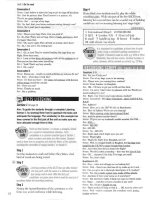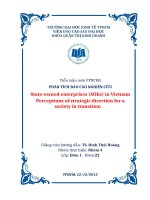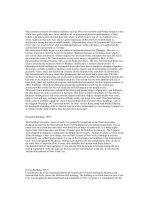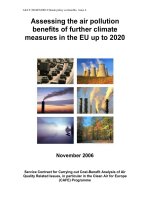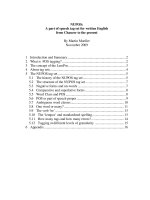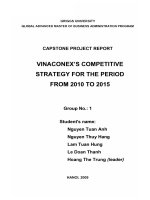STRATEGIC DIRECTION FOR THAIBINH TEA JSC UP TO 2020
Bạn đang xem bản rút gọn của tài liệu. Xem và tải ngay bản đầy đủ của tài liệu tại đây (412.25 KB, 80 trang )
NATIONAL ECONOMICS UNIVERSITY
NEU BUSINESS SCHOOL
MA TRUNG HIEU
STRATEGIC DIRECTION FOR
THAIBINH TEA JSC UP TO 2020
MASTER OF BUSINESS ADMINISTRATION THESIS
HANOI –2013
NATIONAL ECONOMICS UNIVERSITY
NEU BUSINESS SCHOOL
MA TRUNG HIEU
STRATEGIC DIRECTION FOR
THAIBINH TEA JSC UP TO 2020
MASTER OF BUSINESS ADMINISTRATION THESIS
SUPERVISOR: PROF. DR TRAN THO DAT
HANOI –2013
ACKNOWLEDGEMENT
The period of two years participating in the Master of Business
Administration program (EMBA) organized by the Business School of the National
Economics University (BSNEU) has provided me with the most advanced
knowledge in business management. I would like to take this opportunity to send
my gratitude to all professors who have enthusiastically led me through all
important subjects. I have been equipped with numerous ways of scientific thinking
and problem solving. All these knowledge and skill in various fields from the
program have helped me a lot in my current and future.
I would like to express my gratitude to my supervisor, Associate Professor,
Doctor Tran Tho Dat for his assistance and guidance while I was conducting this
thesis. He has given me a lot of valuable advices from the beginning step of my
study until the final writing. He also helped me to search for documents and many
other necessary items for the thesis. I admire his knowledge, experiences in the
fields of strategy study devotion to me.
I would like to thank all my classmates and staffs in Business School have
helped me a lot and provided me a good condition for study, a friendly and open
studying atmosphere. Besides, we also exchanged working experience in different
fields which will be very helpful in our future.
I also have received support from experts, managers and many colleagues in
Thaibinh Tea Joint stock company. Without their support, I could not have
completed the study.
Last but not least, my great thanks to my family, my parents for their strong
support throughout the course of my study.
TABLE OF CONTENTS
TABLE OF CONTENTS.........................................................................................3
ABBREVIATIONS..................................................................................................4
Figure 1.1: Research process Error: Reference source not found.......................6
Figure 2.1: Example of PEST strategy analysis framework (based on Johnson
& Scholes 1993). Error: Reference source not found............................................6
Figure 2.2: Porter’s five competitive forces (based on Porter 1980). Error:
Reference source not found.....................................................................................6
Figure 2.3: Porter’s Four Corners analysis framework (based on Porter 1980).
Error: Reference source not found.........................................................................6
Figure 2.4: The Value Chain Model Error: Reference source not found............6
Figure 2.5: TOWS analysis. Error: Reference source not found.........................6
Figure 3.1: The organizational structure of Thaibinh Tea JSC. Error:
Reference source not found.....................................................................................6
LIST OF TABLE.....................................................................................................7
Table 2.1: TOWS matrix Error: Reference source not found..............................7
Table 3.1: Business results of the Thaibinh Tea JSC Error: Reference source
not found..................................................................................................................7
Table 3.2: Summary of general environment analysis Error: Reference source
not found..................................................................................................................7
Table 3.3: External Factor Evaluation (EFE) Matrix Error: Reference source
not found..................................................................................................................7
Table 3.4: Manufacturing output by the list products of Thaibinh Tea in 2012
Error: Reference source not found.........................................................................7
Table 3.5: Sales revenue by products of Thaibinh Tea in 2012 Error: Reference
source not found......................................................................................................7
Table 3.6: Internal Factor Evaluation (IFE) Matrix 44........................................7
Table 3.7: TOWS Matrix applied to Thaibinh JSC Error: Reference source not
found......................................................................................................................... 7
Table 4.1: Expected results of Thaibinh Tea’s business operations in the period
2013-2020 Error: Reference source not found.......................................................7
LIST OF CHART....................................................................................................8
Chart 2.1: I E Matrix Error: Reference source not found...................................8
Chart 3.1: Several indicators reflect business performance of Thaibinh Tea
Error: Reference source not found.........................................................................8
Chart 3.2: Employment structure by age of Thaibinh Tea JSC in 2012 Error:
Reference source not found.....................................................................................8
Chart 3.3: Employment structure by level of Thaibinh Tea (2012) Error:
Reference source not found.....................................................................................8
Chart 4.1: Distribution of Thaibinh Tea JSC to 2015 Error: Reference source
not found..................................................................................................................8
EXECUTIVE SUMMARY.....................................................................................1
CHAPTER 1 - INTRODUCTION..........................................................................3
CHAPTER 2 - LITERATURE REVIEW AND THEORETICAL
BACKGROUND ON STRATEGIC DIRECTION...............................................8
Strengths - S...........................................................................................................19
Weaknesses – W.....................................................................................................19
If strategic position lies down in 3 blue squares, the enterprise can develop
quickly. If strategic position lies down in 3 yellow squares, the enterprise can
grow selectively. If strategic position lies down in 3 remaining red squares, it is
the best for the enterprise to withdraw gradually...............................................20
CHAPTER 3 – BUSINESS ENVIRONMENT ANALYSIS FOR......................21
THAIBINH TEA JOINT STOCK COMPANY...................................................21
CHAPTER 4 – RECOMMENDATIONS OF STRATEGIC DIRECTION AND
PROPOSALS FOR THAIBINH TEA JSC UP TO 2020....................................52
CONCLUSIONS....................................................................................................65
LIST OF REFERENCES......................................................................................68
GUIDELINES FOR IN-DEPTH INTERVIEW TO LEADERS........................69
INTERVIEW TO THAIBINH TEA JSC EMPLOYEES...................................70
ABBREVIATIONS
ISO
JSC
HACCP
KCS
MOF
UNIDO
:
:
:
:
:
:
International Standards Organization
Joint stock company
Hazard Analysis and Critical Control Point System
Check the product quality
Ministry of Finance
United Nations Industrial Development Organization
WTO
:
World Trade Organization
LIST OF FIGURES
Figure 1.1:
Research process.............................Error: Reference source not found
Figure 2.1:
Example of PEST strategy analysis framework (based on
Johnson & Scholes 1993)..............Error: Reference source not found
Figure 2.2:
Porter’s five competitive forces (based on Porter 1980)...........Error:
Reference source not found
Figure 2.3:
Porter’s Four Corners analysis framework (based on Porter 1980).
........................................................Error: Reference source not found
Figure 2.4:
The Value Chain Model..................Error: Reference source not found
Figure 2.5:
TOWS analysis...............................Error: Reference source not found
Figure 3.1:
The organizational structure of Thaibinh Tea JSC......Error: Reference
source not found
LIST OF TABLE
Table 2.1:
TOWS matrix..................................Error: Reference source not found
Table 3.1:
Business results of the Thaibinh Tea JSC........Error: Reference source
not found
Table 3.2:
Summary of general environment analysis.....Error: Reference source
not found
Table 3.3:
External Factor Evaluation (EFE) Matrix.......Error: Reference source
not found
Table 3.4:
Manufacturing output by the list products of Thaibinh Tea in 2012
........................................................Error: Reference source not found
Table 3.5:
Sales revenue by products of Thaibinh Tea in 2012....................Error:
Reference source not found
Table 3.6:
Internal Factor Evaluation (IFE) Matrix...........................................
Table 3.7:
TOWS Matrix applied to Thaibinh JSC....Error: Reference source not
found
Table 4.1:
Expected results of Thaibinh Tea’s business operations in the
period 2013-2020............................Error: Reference source not found
LIST OF CHART
Chart 2.1:
I E Matrix........................................Error: Reference source not found
Chart 3.1:
Several indicators reflect business performance of Thaibinh Tea
........................................................Error: Reference source not found
Chart 3.2:
Employment structure by age of Thaibinh Tea JSC in 2012........Error:
Reference source not found
Chart 3.3:
Employment structure by level of Thaibinh Tea (2012)..............Error:
Reference source not found
Chart 4.1:
Distribution of Thaibinh Tea JSC to 2015.......Error: Reference source
not found
1
EXECUTIVE SUMMARY
In opening country conditions, more expanding partnerships with many
countries around the world, the domestic enterprises have advantages and
disadvantages for achieving production efficiency. As one of many companies
producing and trading tea, Thaibinh Tea Joint stock company had the significant
contributions to the development and expansion of Vietnamese tea brand in the
world. However, in the trend of increasingly fierce competition today, the Thaibinh
Tea JSC should have strategies to develop stronger and made profit higher. After
studying an overview of Vietnam's tea industry and the company, I decided to do a
study with the subject "Strategic direction for Thaibinh Tea JSC up to 2020".
Within the scope of the study is Strategic direction for Thaibinh Tea JSC up
to 2020, I have generalized theoretical basis for strategy, business strategy, the
factors affecting the strategy, the significance of the strategy and the necessity of
formulating strategy to answer the research question: Which strategic theories are
applicable for research? What are main opportunities & threats of Thaibinh Tea
JSC? What are main strengths & weaknesses of Thaibinh Tea JSC? What are
business strategy directions for Thaibinh Tea JSC from now to 2020?
Thaibinh Tea JSC have participated in the tea market since 1966, the company
has gone through many changes in both the type and structure of our country’s
economy from mechanism of centralized planning to the socialist oriented market
economy. Currently, the company has compact organizational structure of
manufacturing, consistent with mission requirements, including a director of the
company is responsible for operating the main and highest; two deputy directors are
assistants to the director; Administrative and Organized Department with 5 staffs
who advise the Director in the management of training and arrangement, 3 staffs in
Marketing Department advise the Director in the development in the preparation of
planning, organization planning; Accounting Department performs the function of
advising the Director in the management and use of finance; Technical Department
is responsible for the technical examination in the tea processing and after
processing brought to consumption; Two main factories and workshops produce
with modern equipment and machinery.
2
After the process of understanding and analysis of the factors that influence,
strengths, weaknesses, opportunities and threats of the company, I found the company
should do marketing activities comprehensively and more reasonable. In the period
2013-2020, the company should focus on improving product quality, focus on research
and development department. The company aims to expand the market so pricing
strategies of companies in this stage may be lower prices to attract customers or
overvalued at the beginning depends on consumer market and production costs of the
company. Creating a distribution system more widely with many more participants and
finding some new provinces and selling present product or services in new markets.
To implement strategic direction, the company must do some solutions:
Exploitation and management of funds by attracting investment capital from
outside, mobilizing capital in the form of share, adjust the capital structure of the
business and speed up capital rotation; The company should strive to reduce the
cost of doing business, especially in selling expenses and transaction costs; about
solutions of human resource, Establishment of boards for market research, customer
demands, development of product, developing training policies, appointment,
assessment, innovation salary, publicity and fair reward to stimulate and promote
the creation of active employees; Recruitment, attracting talents from outside,
moving the less capable staffs in other departments or reduction of payroll; We have
to make our MIS department stronger because managerial level takes decision on
the basis of information.; About technology solutions, the company needs to pay
more attention to the products with large quantities, but at the same time pay
attention to the variety of items to support each other in terms of finance and meet
the increasing demands of the market. The company should cooperate to other
companies in the industry to build the supply chain and with the State are
responsible for insurance these channels.
With a desire to contribute to the process of improving business performance
in the company and with the knowledge studied in the university and spent time
practicing at Thaibinh Tea, I really learn, find out to see reality more clearly the
importance of the business strategy in the company in particular and business in
general in the market economy. This is just my first research and with the short time
so the reasearch certainly not avoid shortcomings.
3
CHAPTER 1 - INTRODUCTION
1.1. Rationale
Vietnam’s economy is integrated with the economy in the region and the
world, the business environment of the extended enterprise, but the competition is
becoming more intense. That has created business opportunities also contain
potential risks threaten to the development of businesses. And in terms of the
market fluctuation, omit random factor, issues decisions affect the success of the
business. So, to survive and grow, the businesses must determine for themselves the
right strategic plan, if there is no strategic plan or wrong strategic plan, the company
will surely get the failure in business operation.
In the past, many businesses have been successful by only pay attention to
the internal functioning and perform their daily tasks in a most effective way, at
present the majority of businesses, especially small and medium-sized enterprises
meet increasingly volatile business environment, complex and risky. So, just pay
attention to the internal functions and routines is not enough, to survive and to
develop the necessary business plan to find out the right strategy in order to fully
take advantage of business opportunities and limited to the minimum the risk
thereby improving the efficiency and competitiveness of the business. Business
practices in the country and abroad also questioned how successful businesses and
make profits in the changing conditions of the increasingly fierce competitive
environment, scarce resources. Therefore, strategic planning is indispensable. It is
particularly important significance for the future development of the business.
As one of the producing and processing of agricultural products with high
efficiency, Vietnam tea products have been exported to 110 countries and regions
around the world. However, according to the comments of experts, tea product with
localization rate is 100%, but bringing low revenue. So, we need to take measures
and the ways to exploit more effectively.
Beginning participate in the tea market from 1966 to present, Thaibinh Tea
JSC was growing and reaching significant achievements. With 50 years of
4
experience, the company has participated in many markets both domestic and
foreign market, creating its position in the hearts of consumers by affirming the
quality and brand of the company. The company’s products have unique taste and
are processed on high-tech equipment of Taiwan with long experience in
processing. However, the business strategy is not really interested. It is rather
classical in combination with small distribution systems, retail… making affect
business performance of the company.
With awareness of the importance of strategic planning in the enterprise, I
chose the topic: “Strategic direction for Thaibinh Tea JSC up to 2020” to research.
1.2. Research objectives
- To review the strategy theories related on strategic direction.
- To analyze business environment for Thaibinh joint stock company
(internal and external business environment to determine their strengths,
weaknesses, opportunities and threats of the company in the market).
- To propose strategic direction for Thaibinh Tea JSC up to 2020.
1.3. Research scope
The study focuses on strategic direction at Thaibinh Tea JSC. This research is
going to be conducted:
- Location: Lang Son (Thaibinh Tea office) and some provinces in the north
of Viet Nam (Bac Giang, Ha Noi, Hai Duong, Quang Ninh).
- Time:
+ Secondary data: 2010 to 2012.
+ Primary data: from March, 2013 to June, 2013.
5
1.4. Research Methodology
1.4.1. Research process
Review related theory in
Business Strategy
External Environment
Surveys
Interviews
Collecting and
analyzing data
Internal Environment
Surveys
Interviews
Strategic direction
proposals
Strategic direction
decision
Figure 1.1: Research process
1.4.2. Data collection
* Secondary data collection
Secondary data is collected from the documents, statistics, and reports of
Thaibinh Tea JSC. Besides, I also find related documents such as researches,
articles which refer to business strategy.
In addition, data could be collected from reports of organizations or other
strategy’s companies which show information related to this research.
* Primary data collection
- In-depth Interview:
+ Interview to leaders: respondents: 1 director, two deputy directors, one
manager (Department of Finance - Accounting) who understand fully and detail
about the company with the purpose is collecting information about the strengths,
6
weaknesses, opportunities, challenges, achievements which the company reached
over time and the company's plans in the near future.
+ Interview to Staff: respondents: 10 staff. This aims to understand more
about company situation.
+ Interview method: The interviews were conducted by phone, and interview
directly.
- Survey:
+ Survey agents:
Respondants: agents of the company
Sample size: 10 agents (4 agents in Lang Son, 2 agents in
Quang Ninh, 1 agent in Ha Noi and 1 agent in Bac Giang)
Sample method: all agents of the company.
Question description: as in Questionnare to customers and
Agents understand about the quality product & service of
company.
Question distribution: surveying directly.
+ Survey Customers:
Respondants: Customers of the company
Sample size: 40 customers.
Sample method: random selection customer.
Question description: as in Questionnare to customers and
Agents understand about the quality product & service of
company.
Question distribution: surveying directly.
1.4.3. Data processing
Base on result of survey, data is collected and handled by Excel program.
Outputs of analysis are showed in data tables and diagrams, graphs.
7
1.5. Thesis structure
Besides forewords, conclusion and list of table and abbreviation the capstone
project includes three chapters as following:
Chapter 1: Introduction
Chapter 2: Literature review and Theoretical background on strategic
direction
In this chapter, the author summarizes relevant theories which are used to
implement the strategic direction for Thaibinh Tea JSC.
Chapter 3: Business environment analysis for Thaibinh Tea JSC.
The author summarizes and analyze environment of the company.
Chapter 4: Recommendations of strategic direction and Proposals for
Thaibinh Tea JSC up to 2020.
8
CHAPTER 2 - LITERATURE REVIEW AND THEORETICAL
BACKGROUND ON STRATEGIC DIRECTION
2.1. Definitions of strategy and strategic management
“Strategy” is the term which has been widely and long standing used in
many fields. “Strategy” was firstly used in military then in political field. From
1950s to 1960s of XX century, the concept of “strategy” was used in economic and
social field. Generally, “strategy” was understood as trend and method to resolve
long term and overview mission. According to UNIDO definition: “Generally, a
development strategy can be described as an outline of developing process to reach
intended targets for a period from 10 to 20 years, it instruct strategic managers in
attracting and allocating resources. It can be said that, strategy provides a vision for
development process and the consistence for implement solutions. Strategy also can
be basics for overview developing plan in long term and short term or can be
general awareness of related people about prospects and willingness and challenges
in a specific period”
There are many definition of “strategy”. To Fred R. David (2003), strategy
includes numbers of method to reach long term target. To Michael E. Porter (1996),
strategy is the creation of special and valuable positions include variable activities.
In general, there are some differences in expression of concepts and
definitions of strategy. They still have some common content:
+ Define company’s short term and long term targets
+ Bring out solutions and methods to choose these solutions
+ Deploy and allocate resource to implement these targets.
Besides understanding concept of strategy managers of company also need to
know the way to manage these strategies and make right decisions to reach
company’s target, this process is called strategic management. I can be generally
said that: “Strategic management is defined as a set of decisions and actions
expressed via results of planning, implement and evaluating strategies, created to
reach corporation’s long-run targets”
Strategic management includes these following specific steps:
9
+ Strategic planning
+ Strategic implement
+ Strategic checking and evaluation.
2.2. Roles of strategy and strategic management
Characteristics of business environment have a big affect to existence and
development of company. They can create new opportunities and challenges for
corporation. And the company which wants to exist has to find out a new
management method, it is exactly “strategic management” - strategy is the basis of
this management method. In model business environment, strategy becomes more
and more important to existence of company. These roles are:
- Strategy is the tool that generally shows the long-term goals of the
organization or enterprise. Enterprise’s goals are special targets which it wants to
reach during its operation process. Specialization and making documents these
targets via strategies will help members of enterprise or organizations when finding
the targets which they want to reach so, they will know what they have to do. It will
help the enterprise easier in reaching its goals.
- Strategy connects short term targets closely in long run conditions. In
model business situation, every enterprise has to flexibly move to adapt to changing
of environment. Sometimes this movement will make the enterprise be separated
from its long term goals. In this case, strategy with strategic goals will help
managers of enterprise a long run direction. So, resolving short term matters in long
run conditions can bring enterprise a stable development. Long run goals also are
basics for short term goals.
- Strategy helps to ensure unification and make plans for enterprise’s
activities. In existence and development process, strategy provides a comprehensive
and logical point of view in resolving problems which arises in business
performance. Strategy also helps to associate different sections in a company and
orient them to reach to a unit goal, it is enterprise’s goal.
- Strategy helps enterprises and organizations to catch up with market
opportunities and create comparative position in the market. Strategy unifies the
enterprise’s operation process in order to reach to enterprise’s strategic goals. It
10
means that enterprise will have to use its resource in most efficient way. So,
enterprises have to choose fastest way to catch up with market opportunities and
deploy its available abilities to create new comparative advantages.
Form below analysis we can see very important roles of strategy in
enterprise’s performance so, strategic management becomes one of the most
necessary keys which helps enterprise open the door to advance toward success.
Strategic management brings theses following advantages:
- More efficient in making plans by using more reasonable and logical
approach method when choosing strategies.
- Widely take care of related beneficiaries of enterprises (stock holders)
- Connect short term development in long term development.
- Take care of both efficiency and effectiveness.
2.3. Models for business environment analysis
2.3.1. Model for external environment analysis
2.3.1.1. PEST analysis
The PEST analysis framework considers political, economic, socio-cultural, and
technological aspects (see Figure 2.1 for an example). The framework is composed of
four segments. The first lists the political aspects that are considered in the analysis.
The second, third, and fourth segments identify economic, socio - culture, and
technological features. A target company’s strategy is evaluated against these elements
when performing strategy analysis (Johnson & Scholes 1993b).
Political
- Environmental laws
- Taxation policy
- Foreign trade regulations
Socio – Cultural
- Education level
- Income distribution
- Lifestyle changes
Economic
- Business cycles
- Unemployment
- Energy availability
Technology
- New discoveries
- Technology transfers
- Research spending
Figure 2.1: Example of PEST strategy analysis framework
(based on Johnson & Scholes 1993).
PEST analysis can be applied in strategy analysis specifically as a tool for
11
understanding the drivers of long-term change. The four aspects in this tool can
help determine why and how these changes occur in an industry and what longterm trends underlie such variations. These themes comprise phenomena such as
globalization, convergence of consumer tastes, rapid technological changes, and
so on. PEST analysis enables the examination of competitor differentiation within
these aspects. This examination affords enterprises a thorough comprehension of
how changes may affect competitive position in markets - a valuable advantage
given that the effect of change can vary depending on company competencies,
skills, and market position.
2.3.1.2. Five Forces analysis
One of the most well-known strategy analysis frameworks is Porter’s
(1980) Five Forces analysis (Figure 2.2), which comprises five sections: power of
suppliers, power of buyers, threat of new entrants, and threat of substitutes.
These sections can be used in strategy analysis as views on how the competitive
position and strategy of a firm is evaluated.
Figure 2.2: Porter’s five competitive forces (based on Porter 1980).
Suppliers can command power over an industry by introducing price
increases or by reducing quality level. Powerful suppliers can therefore introduce
cost elements from which companies in the industry cannot recover, resulting in
12
low profitability. The power of buyers comes in the form of demand for low
prices and high quality, as well as inducing competition amongst firms. The
threat of new entrants that bring new capacity and lower prices heavily influence a
company’s strategy within the industry, similar to how the threat of substitute
products draws part of demand away from the products that the industry produces.
The actual potential of these entrants depends on many factors, such as barriers to
entry, which are important issues in the analysis. All the five forces compete for
a fixed pool of resources, and this competition determines the ability of any
individual company to earn profits in the industry. Porter views the competition as a
zero-sum game; thus, more of the outside forces become stronger, creating a
weaker strategic position for the company within that industry (Porter 1980,
Werther & Chandler 2011, Thompson 1993).
Porter also states that the competitive situation of a firm is set primarily
by competition within the industry itself. This industry rivalry depends on
economic and industry structure; hence, various industries can have significantly
different levels of internal competition. The outside forces that influence such
competition are relatively important because they highlight the different abilities of
the companies to respond to these forces (Porter 1980).
Porter’s strategy analysis framework is constrained by three factors, which
stem from the definition of industry and competition as a zero-sum game. First, the
idea that a customer or supplier’s advantage is always gained at the expense of a
company dictates that in Porter’s model, a company should always stay ahead of its
stakeholders to create competitive advantage. Second, the five forces are missing
several influential factors and stakeholders in the analysis, such as governments or
local communities. Third, Porter’s strategy analysis framework fails to differentiate
companies on the basis of their characteristics, and therefore leaves unanswered
questions as to the strategy analysis that is based on a company’s internal aspects,
drivers, and organizational orientation (Werther & Chandler 2011).
2.3.1.3. Four Corners analysis
13
Another strategy analysis framework proposed by Porter (1980) is the Four
Corners model, which focuses on understanding competitors’ strategies but can
also be used for the “self – analysis” of a company’s own strategy. An example
of this framework is illustrated in Figure 2.3.
FUTURE GOALS
CURRENT STRATEGY
- Financial goals
- How the business creates value.
- Leadership team background
- Where the business invest.
- External constraints.
- Networks the business has.
Etc.
Etc.
Competitor’s Future Strategy
ASSUMPTIONS
CAPABILITIES
- Perceived industry forces.
- Marketing skill.
- Belief about competition goals.
- Skill of the workforce.
- Cultural, regional or national
differences.
- Patents and copyrights.
Etc.
Etc.
- Financial strengths.
Figure 2.3: Porter’s Four Corners analysis framework (based on Porter 1980).
The analysis framework is composed of four diagnostic components:
future goals, current strategy, assumptions, and capabilities. Understanding these
four components provides insight into competitors’ future strategies. Each
component can carry a set of questions and characteristics for the purpose of
analysis (Porter 1980).
The future goals section is derived from the important perspective that
14
companies have different goals and thus pursue varied strategic moves. For
example, a competitor’s financial goals reflect its current situation or whether it is
looking to implement change. Leadership team background provides indications
of goal setting and rewarding practices, and external constraints can signify
whether a company can be more sensitive to certain players in the industry, such
as government regulators (Porter 1980).
The assumptions section presents another interesting view of a competitor’s
strategy. This perspective is related primarily to two aspects: a competitor’s
assumptions about a rival company and a competitor’s assumptions on the industry
and the other companies in it. This component can comprise questions and
characteristic elements such as perceived industry forces and a company’s relative
position regarding these. Similarly, beliefs about competitor goals have influence, as
well as regional, cultural, and national differences, that may be seen as orientation
towards product quality at the expense of unit cost (Porter 1980).
The third component of the analysis framework is a competitor’s current
strategy, which may be explicit or implicit. The aspects to consider here are value
creation path, business investment focus, and the overall statements of a company’s
future direction. In the simplest manner, the strategy characteristics in this
section can be regarded as built from key visible operating procedures that a
competitor has in place (Porter 1980).
The fourth component is capabilities, which determine a competitor’s
ability to respond to strategic moves or industry changes. This section can feature
a wide list of characteristics to be used as bases for analysis. Some examples are
marketing skills, overall education of the employees, company patents and
copyrights, or the financial strengths of a competitor. A TOWS analysis type of
approach can be used to gather information, which is then incorporated into this
section to complete the Four Corners strategy analysis (Porter 1980).
When completed, the analysis framework can be used to plot the
offensive and defensive scenarios of a competitor or if the analysis is intended
for company self-assessment, it can focus on creating strategic positioning
15
scenarios for the company (Porter 1980).
2.3.2. Model for internal environment analysis
An internal company analysis is an evaluation of a company’s current
position from the combined perspectives of marketing, operations, and finance for
strategic use. The company has to take advantage of strengths and try to minimize
weaknesses to direct an appropriate business strategy. The following area analyses
are often used to look at internal factors effect to company:
2.3.2.1. Value Chain Model
The value chain is a systematic approach to examine the development of
competitive advantage. It was created by Michael E. Porter in his book,
Competitive Advantage (1980). Every firm has two main activities that are primary
activities (inbound logistics, operations, outbound logistics, marketing & sales,
service) and support activities (infrastructure, human resource management,
technology development, procurement).
Figure 2.4: The Value Chain Model
- Inbound logistics are primarily associated with receiving, storing and
distributing inputs to the product. It includes material handling, warehousing,
inventory control, vehicle scheduling, and returns to suppliers.
- Operations include all activities associated with transforming inputs into
16
final product form, such as machining, packaging, assembling, testing, printing, and
facility operation.
- Outbound logistics composes collecting, storing and distributing the
products and services to buyers.
- Marketing and sales include advertising, promotion, sale force, quoting,
channel selection, and pricing.
- Services are to enhance or maintain the value of the product (installation,
repair, training, etc).
- Firm infrastructure includes supports such as general management,
planning, finance, accounting, government affair, information system.
- Human resource management includes recruitment, hiring, training,
development, and compensation of all type of personnel.
- Technology development is very important in the modern life and modern
economy.
- Procurement refers to the function of purchasing inputs used in the firm’s
value chain. Purchased inputs are raw materials, supplies, and other consumable
items and assets.
2.3.2.2. The Internal Factor Evaluation (IFE) Matrix
The IFE Matrix summarizes and evaluates the major strengths and
weaknesses in the functional areas of a business, and it also provides a basis for
identifying and evaluating relationships among those areas. An IFE Matrix can be
developed in five steps:
- Step 1: List key internal factor use a total of from 10 to 20 internal factors,
including both strengths and weaknesses.
- Step 2: Assign a weight that ranges from 0.0 (not important) to 1.0 (all
important) to each factor. The sum of all weights must equal 1.0.
- Step 3: Assign a 1-to-4 rating to each factor to indicate whether that factor
represents a major weakness (rating = 1), a minor weakness (rating = 2), a minor
strength (rating =3), or a major strength (rating = 4).
- Step 4: Multiply each factor’s weight by its rating to determine a weighted

